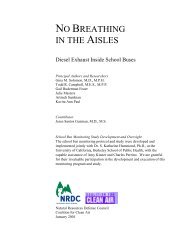US Nuclear Weapons in Europe - Natural Resources Defense Council
US Nuclear Weapons in Europe - Natural Resources Defense Council
US Nuclear Weapons in Europe - Natural Resources Defense Council
Create successful ePaper yourself
Turn your PDF publications into a flip-book with our unique Google optimized e-Paper software.
U.S. <strong>Nuclear</strong> <strong>Weapons</strong> <strong>in</strong> <strong>Europe</strong> • Hans M. Kristensen/<strong>Natural</strong> <strong>Resources</strong> <strong>Defense</strong> <strong>Council</strong>, 2005<br />
More Policy Ref<strong>in</strong>ement but Little Actual Change<br />
Greece’s historic departure from NATO’s nuclear club was not cited <strong>in</strong> the f<strong>in</strong>al<br />
communiqué from the NPG meet<strong>in</strong>g <strong>in</strong> Brussels <strong>in</strong> June 2001, which reaffirmed the<br />
importance of the nuclear posture and declared that it had f<strong>in</strong>ally implemented the<br />
Strategic Concept adopted <strong>in</strong> 1991:<br />
“Ten years ago, with the 1991 Strategic Concept, the alliance embarked on<br />
a number of decisive strategy and policy changes to adapt to the post–Cold<br />
War security situation. Look<strong>in</strong>g back, we are satisfied that NATO's new<br />
strategy of reduced reliance on nuclear weapons, reaffirmed <strong>in</strong> the 1999<br />
Strategic Concept, has been fully translated <strong>in</strong>to NATO doctr<strong>in</strong>e, and that<br />
NATO's drastically reduced nuclear force posture fully complies with<br />
alliance key pr<strong>in</strong>ciples. <strong>Nuclear</strong> forces are a credible and effective<br />
element of the alliance's strategy of prevent<strong>in</strong>g war; they are ma<strong>in</strong>ta<strong>in</strong>ed at<br />
the m<strong>in</strong>imum level sufficient to preserve peace and stability, under<br />
conditions that cont<strong>in</strong>ue to meet the highest standards of safety and<br />
security.” 188<br />
The strategy of reduced but cont<strong>in</strong>ued reliance on U.S. forward-deployed nuclear<br />
weapons <strong>in</strong> <strong>Europe</strong> as adopted by the 1991 Strategic Concept (and “reaffirmed <strong>in</strong> the<br />
1999 Strategic Concept”), emanated from a time when the Soviet Union still existed and<br />
NATO deployed some 4,000 nuclear weapons <strong>in</strong> <strong>Europe</strong>. In the early 1990s, it was<br />
important to draw down the forces and reduce the alert level, but one would have hoped<br />
that that process had been completed long before 2001 and that a realization had emerged<br />
that the rema<strong>in</strong><strong>in</strong>g nuclear bombs <strong>in</strong> <strong>Europe</strong> do not serve NATO’s <strong>in</strong>terests <strong>in</strong> the 21 st<br />
century. But NATO cont<strong>in</strong>ues to say they do. There seems little difference between the<br />
rationale used for keep<strong>in</strong>g U.S. nuclear bombs <strong>in</strong> <strong>Europe</strong> under the 1991 Strategic<br />
Concept and that offered by the NATO communiqué a decade later:<br />
1991 Strategic Concept: “A credible alliance nuclear posture and the<br />
demonstration of alliance solidarity and common commitment to war<br />
prevention cont<strong>in</strong>ue to require widespread participation by <strong>Europe</strong>an allies<br />
<strong>in</strong>volved <strong>in</strong> collective defence plann<strong>in</strong>g <strong>in</strong> nuclear roles, <strong>in</strong> peacetime<br />
bas<strong>in</strong>g of nuclear forces on their territory and <strong>in</strong> command, control, and<br />
consultation arrangements. <strong>Nuclear</strong> forces based <strong>in</strong> <strong>Europe</strong> and<br />
committed to NATO provide an essential political and military l<strong>in</strong>k<br />
between the <strong>Europe</strong>an and the North American members of the alliance.<br />
The alliance will therefore ma<strong>in</strong>ta<strong>in</strong> adequate nuclear forces <strong>in</strong> <strong>Europe</strong>.<br />
These forces need to have the necessary characteristics and appropriate<br />
flexibility and survivability to be perceived as a credible and effective<br />
element of the Allies' strategy <strong>in</strong> prevent<strong>in</strong>g war. They will be ma<strong>in</strong>ta<strong>in</strong>ed<br />
at the m<strong>in</strong>imum level sufficient to preserve peace and stability.” 189<br />
60
















